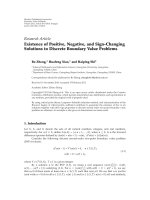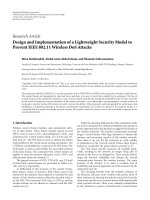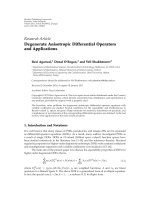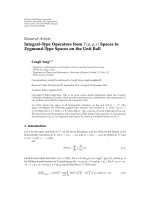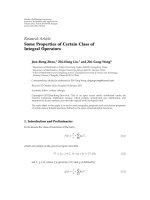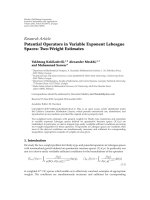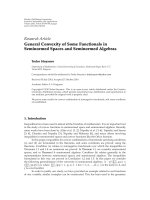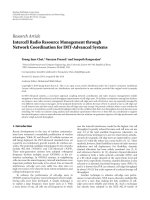Báo cáo hóa học: " Research Article Integral-Type Operators from F p, q, s Spaces to Zygmund-Type Spaces on the Unit Ball Congli Yang1, 2" ppt
Bạn đang xem bản rút gọn của tài liệu. Xem và tải ngay bản đầy đủ của tài liệu tại đây (530.86 KB, 14 trang )
Hindawi Publishing Corporation
Journal of Inequalities and Applications
Volume 2010, Article ID 789285, 14 pages
doi:10.1155/2010/789285
Research Article
Integral-Type Operators from Fp, q, s Spaces to
Zygmund-Type Spaces on the Unit Ball
Congli Yang
1, 2
1
Department of Mathematics and Computer Science, Guizhou Normal University,
550001 Gui Yang, China
2
Department of Physics and Mathematics, University of Eastern Finland, P.O. Box 111,
80101 Joensuu, Finland
Correspondence should be addressed to Congli Yang, congli.yang@uef.fi
Received 7 May 2010; Revised 21 September 2010; Accepted 23 December 2010
Academic Editor: Siegfried Carl
Copyright q 2010 Congli Yang. This is an open access article distributed under the Creative
Commons Attribution License, which permits unrestricted use, distribution, and reproduction in
any medium, provided the original work is properly cited.
Let H
B denote the space of all holomorphic functions on the unit ball B ⊂ C
n
. This
paper investigates the following integral-type operator with symbol g ∈ H
B, T
g
fz
1
0
ftzRgtzdt/t, f ∈ HB, z ∈ B,whereRgz
n
j1
z
j
∂g/∂z
j
z is the radial derivative of g.
We characterize the boundedness and compactness of the integral-type operators T
g
from general
function spaces Fp, q, s to Zygmund-type spaces Z
μ
,whereμ is normal function on 0, 1.
1. Introduction
Let B be the open unit ball of C
n
,let∂B be its boundary, and let HB be the family of all
holomorphic functions on B.Letz z
1
, ,z
n
and w w
1
, ,w
n
be points in C
n
and
z, w z
1
w
1
··· z
n
w
n
.
Let
Rf
z
n
j1
z
j
∂f
∂z
j
z
1.1
stand for the radial derivative of f ∈ HB. For a ∈ B,letgz, alog1/|ϕ
a
z|, where ϕ
a
is
the M
¨
obius transformation of B satisfying ϕ
a
0a, ϕ
a
a0, and ϕ
a
ϕ
−1
a
. For 0 <p,s<∞,
−n − 1 <q<∞,wesayf ∈ Fp, q, s provided that f ∈ HB and
f
p
Fp,q,s
f
0
p
sup
a∈B
B
Rf
z
p
1 −
|
z
|
2
q
g
s
z, a
dv
z
< ∞.
1.2
2 Journal of Inequalities and Applications
The space Fp, q, s, introduced by Zhao in 1, is known as the general family of
function spaces. For appropriate parameter values p,q,ands, Fp, q, s coincides with several
classical function spaces. For instance, let D be the unit disk in C, Fp, q, sB
q2/p
if
1 <s<∞ see 2, where B
α
, 0 <α<∞, consists of those analytic functions f in D for
which
f
B
α
sup
z∈D
1 −
|
z
|
2
α
f
z
< ∞.
1.3
The space Fp, p, 0 is the classical Bergman space A
p
A
p
0
see 3, Fp, p − 2, 0 is the
classical Besov space B
p
, and, in particular, F2, 1, 0 is just the Hardy space H
2
. The spaces
F2, 0,s are Q
s
spaces, introduced by Aulaskari et al. 4, 5. Further, F2, 0, 1BMOA,the
analytic functions of bounded mean oscillation. Note that Fp, q, s is the space of constant
functions if q s ≤−1. More information on the spaces Fp, q, s can be found in 6, 7.
Recall that the Bloch-type spaces or α-Bloch space B
α
B
α
B,α > 0, consists of all
f ∈ HB for which
b
α
f
sup
z∈B
1 −
|
z
|
2
α
Rf
z
< ∞.
1.4
The little Bloch-type space B
α
0
BB
α
0
consists of all f ∈ HB such that
lim
|z|→1
1 −
|
z
|
2
α
Rf
z
0.
1.5
Under the norm introduced by f
B
α
|f0| b
α
f, B
α
is a Banach space and B
α
0
is
a closed subspace of B
α
.Ifα 1, we write B and B
0
for B
1
and B
1
0
, respectively.
A positive continuous function μ on the interval 0,1 is called normal if there are three
constants 0 ≤ δ<1and0<a<bsuch that
μ
r
1 − r
a
is decreasing on
δ, 1
, lim
r → 1
μ
r
1 − r
a
0,
μ
r
1 − r
b
is increasing on
δ, 1
, lim
r → 1
μ
r
1 − r
b
∞.
1.6
Let Z ZB denote the class of all f ∈ HB such that
sup
z∈B
1 −
|
z
|
2
R
2
f
z
< ∞.
1.7
Write
f
Z
f
0
sup
z∈B
1 −
|
z
|
2
R
2
f
z
.
1.8
Journal of Inequalities and Applications 3
With the norm ·
Z
, Z is a Banach space. Z is called the Zygmund space see 8.LetZ
0
denote the class of all f ∈ HB such that
lim
|
z
|
→ 1
1 −
|
z
|
2
R
2
f
z
0.
1.9
Let μ be a normal function on 0,1. It is natural to extend the Zygmund space to a
more general form, for an f ∈ HB, we say that f belongs to the space Z
μ
Z
μ
B if
sup
z∈B
μ
|
z
|
R
2
f
z
< ∞.
1.10
It is easy to check that Z
μ
becomes a Banach space under the norm
f
Z
μ
f
0
sup
z∈B
μ
|
z
|
R
2
f
z
,
1.11
and Z
μ
will be called the Zygmund-type space.
Let Z
μ,0
denote the class of holomorphic functions f ∈Z
μ
such that
lim
|
z
|
→ 1
μ
|
z
|
R
2
f
z
0,
1.12
and Z
μ,0
is called the little Zygmund-type space. When μr1 − r,from8, page 261,we
say that f ∈Z
1−r
: Z if and only if f ∈ AB, and there exists a constant C>0 such that
f
ζ h
f
ζ − h
− 2f
ζ
<C
|
h
|
, 1.13
for all ζ ∈ ∂B and ζ ± h ∈ ∂B, where AB is the ball algebra on B.
For g ∈ HB, the following integral-type operator so called extended Ces
`
aro
operator is
T
g
f
z
1
0
f
tz
Rg
tz
dt
t
,
1.14
where f ∈ HB and z ∈ B.Stevi
´
c 9 considered the boundedness of T
g
on α-Bloch spaces.
Lv and Tang got the boundedness and compactness of T
g
from Fp, q, s to μ-Bloch spaces for
all 0 <p,s<∞, −n − 1 <q<∞ see 10. Recently, Li and Stevi
´
c discussed the boundedness
of T
g
from Bloch-type spaces to Zygmund-type spaces in 11. For more information about
Zygmund spaces, see 12, 13.
In this paper, we characterize the boundedness and compactness of the operator T
g
from general analytic spaces Fp, q, s to Zygmund-type spaces.
In what follows, we always suppose that 0 <p, s<∞, −n − 1 <q<∞, q s>−1.
Throughout this paper, constants are denoted by C; they are positive and may have different
values at different places.
4 Journal of Inequalities and Applications
2. Some Auxiliary Results
In this section, we quote several auxiliary results which will be used in the proofs of our main
results. The following lemma is according to Zhang 14.
Lemma 2.1. If f ∈ Fp, q, s,thenf ∈B
n1q/p
and
f
B
n1q/p
≤
f
Fp,q,s
.
2.1
Lemma 2.2 see 9. For 0 <α<∞,iff ∈ B
α
, then for any z ∈ B
f
z
≤
⎧
⎪
⎪
⎪
⎪
⎪
⎨
⎪
⎪
⎪
⎪
⎪
⎩
C
f
B
α
, 0 <α<1,
C
f
B
α
log
2
1 −
|
z
|
2
,α 1,
C
f
B
α
1 −
|
z
|
2
1−α
,α>1.
2.2
Lemma 2.3 see 15. For every f, g ∈ HB, it holds RT
g
fzfzRgz.
Lemma 2.4 see 10. Let p n 1 q. Suppose that for each w ∈ B, z-variable functions g
w
satisfy |g
w
z|≤C/|1 −z, ω|,then
B
g
ω
z
p
1 −
|
z
|
2
q
g
s
z, a
dv
z
≤ C.
2.3
Lemma 2.5. Assume that g ∈ HB, 0 <p, s<∞, −n − 1 <q<∞, and μ is a normal function on
0, 1,thenT
g
: Fp,q, s →Z
μ
or Z
μ,0
is compact if and only if T
g
: Fp,q, s →Z
μ
or Z
μ,0
is bounded, and for any bounded sequence {f
k
}
k∈N
in Fp, q, s which converges to zero uniformly on
compact subsets of B as k →∞, one has lim
k →∞
T
g
f
Z
μ
0.
The proof of Lemma 2.5 follows by standard arguments see, e.g., Lemma 3 in 16.
Hence, we omit the details.
The following lemma is similar to the proof of Lemma 1 in 17. Hence, we omit it.
Lemma 2.6. Let μ be a normal function. A closed set K in Z
μ,0
is compact if and only if it is bounded
and satisfies
lim
|
z
|
→ 1
sup
f∈K
μ
|
z
|
R
2
f
z
0.
2.4
3. Main Results and Proofs
Now, we are ready to state and prove the main results in this section.
Theorem 3.1. Let 0 <p, s<∞, −n − 1 <q<∞, and let μ be normal, g ∈ HB and n 1 q ≥ p,
then T
g
: Fp, q, s →Z
μ
is bounded if and only if
Journal of Inequalities and Applications 5
i for n 1 q>p,
M
1
sup
z∈B
μ
|
z
|
Rg
z
1 −
|
z
|
2
−n1q/p
< ∞
, 3.1
M
2
sup
z∈B
μ
|
z
|
R
2
g
z
1 −
|
z
|
2
1−n1q/p
< ∞,
3.2
ii for n 1 q p,
M
3
sup
z∈B
μ
|
z
|
Rg
z
1 −
|
z
|
2
−1
< ∞
, 3.3
M
4
sup
z∈B
μ
|
z
|
R
2
g
z
log
2
1 −
|
z
|
2
< ∞.
3.4
Proof. i First, for f, g ∈ HB, suppose that n 1 q>pand f ∈ Fp, q, s. By Lemmas
2.1–2.3, we write R
2
f RRf. We have that
T
g
f
Z
μ
T
g
f
0
sup
z∈B
μ
|
z
|
R
2
T
g
f
z
≤ sup
z∈B
μ
|
z
|
Rf
z
Rg
z
f
z
R
2
g
z
≤
f
B
n1q/p
sup
z∈B
μ
|
z
|
Rg
z
1 −
|
z
|
2
−n1q/p
C
f
B
n1q/p
sup
z∈B
μ
|
z
|
R
2
g
z
1 −
|
z
|
2
1−n1q/p
≤ C
f
Fp,q,s
sup
z∈B
μ
|
z
|
Rg
z
1 −
|
z
|
2
−n1q/p
C
f
Fp,q,s
sup
z∈B
μ
|
z
|
R
2
g
z
1 −
|
z
|
2
1−n1q/p
.
3.5
Hence, 3.1 and 3.2 imply that T
g
: Fp, q, s →Z
μ
is bounded.
Conversely, assume that T
g
: Fp, q, s →Z
μ
is bounded. Taking the test function
fz ≡ 1 ∈ Fp, q, s,weseethatg∈Z
μ
,thatis,
sup
z∈B
μ
|
z
|
R
2
g
z
< ∞.
3.6
6 Journal of Inequalities and Applications
For w ∈ B,set
f
w
z
1 −
|
w
|
2
1n1q/p
1 −
z, w
2n1q/p
−
1 −
|
w
|
2
1 −
z, w
n1q/p
,z∈ B.
3.7
Then, f
w
Fp,q,s
≤ C by 14 and f
w
w0.
Hence,
∞ >
T
g
f
w
Z
μ
≥ sup
z∈B
μ
|
z
|
R
2
T
g
f
w
z
sup
z∈B
μ
|
z
|
Rf
w
z
Rg
z
f
w
z
R
2
g
z
≥ μ
|
w
|
Rf
w
w
Rg
w
f
w
w
R
2
g
w
μ
|
w
|
Rf
w
w
Rg
w
μ
|
w
|
Rg
w
|
w
|
2
1 −
|
w
|
2
n1q/p
.
3.8
From 3.8, we have
sup
|
w
|
>1/2
μ
|
w
|
Rg
w
1 −
|
w
|
2
n1q/p
< 4sup
|
w
|
>1/2
μ
|
w
|
Rg
w
|
w
|
2
1 −
|
w
|
2
n1q/p
≤ 4
T
g
f
w
Z
μ
< ∞.
3.9
On the other hand, we have
sup
|
w
|
≤1/2
μ
|
w
|
Rg
w
1 −
|
w
|
2
n1q/p
<C sup
|
w
|
≤1/2
μ
|
w
|
Rg
w
< ∞.
3.10
Combing 3.9 and 3.10,weget3.1.
In order to prove 3.2,letw ∈ B and set
h
w
z
1 −
|
w
|
2
1 −
z, w
n1q/p
.
3.11
Journal of Inequalities and Applications 7
It is easy to see that h
w
w1/1 −|w|
2
n1q/p−1
, Rh
w
w ≈|w|
2
/1 −|w|
2
n1q/p
.
We know that h
w
∈ Fp, q, s; moreover, there is a positive constant C such that h
w
Fp,q,s
≤
C. Hence,
∞ >
T
g
h
w
Z
μ
≥ sup
z∈B
μ
|
z
|
R
2
T
g
h
w
z
sup
z∈B
μ
|
z
|
Rh
w
z
Rg
z
h
w
z
R
2
g
z
≥ μ
|
w
|
R
2
g
w
1 −
|
w
|
2
1−n1q/p
−
μ
|
w
|
Rg
w
|
w
|
2
1 −
|
w
|
2
n1q/p
.
3.12
From 3.1 and 3.12,weseethat3.2 holds.
ii If n1q p, then, by Lemmas 2.1 and 2.2, we have Fp, q, s ⊆B
1
,forf ∈ Fp, q, s,
we get
T
g
f
Z
μ
T
g
f
0
sup
z∈B
μ
|
z
|
R
2
T
g
f
z
≤ sup
z∈B
μ
|
z
|
Rf
z
Rg
z
f
z
R
2
g
z
≤
f
B
1
sup
z∈B
μ
|
z
|
Rg
z
1 −
|
z
|
2
−1
C
f
B
1
sup
z∈B
μ
|
z
|
R
2
g
z
log
2
1 −
|
z
|
2
≤ C
f
Fp,q,s
sup
z∈B
μ
|
z
|
Rg
z
1 −
|
z
|
2
−1
C
f
Fp,q,s
sup
z∈B
μ
|
z
|
R
2
g
z
log
2
1 −
|
z
|
2
.
3.13
Applying 3.3 and 3.4 in 3.13, for the case n 1 q p, the boundedness of the operator
T
g
: Fp, q, s →Z
μ
follows.
Conversely, suppose that T
g
: Fp, q, s →Z
μ
is bounded. Given any w ∈ B,set
f
w
z
1 −
|
w
|
2
2
1 −
z, w
2
−
1 −
|
w
|
2
1 −
z, w
,z∈ B,
3.14
then f
w
Fp,q,s
≤ C by 14.
8 Journal of Inequalities and Applications
By the boundedness of T
g
,itiseasytoseethat
μ
|
w
|
Rg
w
|
w
|
2
1 −
|
w
|
2
< ∞.
3.15
By 3.14 and 3.15, in the same way as proving 3.1,wegetthat3.3 holds.
Now, given any w ∈ B,set
f
w
z
log
2
1 −
z, w
,z∈ B,
3.16
then |Rf
w
z|≤C/|1 −z, w|. Applying Lemma 2.4, we have that f
w
Fp,q,s
≤ C. Hence,
∞ >
T
g
f
w
Z
μ
≥ sup
z∈B
μ
|
z
|
R
2
T
g
f
w
z
≥ sup
z∈B
μ
|
z
|
Rf
w
z
Rg
z
f
w
z
R
2
g
z
≥ μ
|
w
|
R
2
g
w
log
2
1 −
|
w
|
2
−
μ
|
w
|
Rg
w
|
w
|
2
1 −
|
w
|
2
.
3.17
From 3.15 and 3.17,weseethat3.4 holds. The proof of this theorem is completed.
Theorem 3.2. Let 0 <p, s<∞, −n − 1 <q<∞, and let μ be normal, g ∈ HB and n 1 q ≥ p,
then the following statements are equivalent:
A T
g
: Fp, q, s →Z
μ
is compact;
B T
g
: Fp, q, s →Z
μ,0
is compact;
Ci for n 1 q>p,
lim
|
z
|
→ 1
μ
|
z
|
Rg
z
1 −
|
z
|
2
−n1q/p
0,
3.18
lim
|
z
|
→ 1
μ
|
z
|
R
2
g
z
1 −
|
z
|
2
1−n1q/p
0,
3.19
ii for n 1 q p,
lim
|
z
|
→ 1
μ
|
z
|
Rg
z
1 −
|
z
|
2
−1
0,
3.20
lim
|
z
|
→ 1
μ
|
z
|
R
2
g
z
log
2
1 −
|
z
|
2
0.
3.21
Journal of Inequalities and Applications 9
Proof. B ⇒ A. This implication is obvious.
A ⇒ C. First, for the case n 1 q>p.
Suppose that the operator T
g
: Fp, q, s →Z
μ
is compact. Let {z
k
}
k∈N
be a sequence
in B such that lim
k →∞
|z
k
| 1. Denote f
k
zf
z
k
z,k ∈ N,andset
f
k
z
1 −
|
z
k
|
2
1n1q/p
1 −
z, z
k
2n1q/p
−
1 −
|
z
k
|
2
1 −
z, z
k
n1q/p
,k∈ N.
3.22
It is easy to see that f
k
∈ Fp, q, s for k ∈ N and f
k
→ 0 uniformly on compact subsets of B
as k →∞.ByLemma 2.5, it follows that
lim
k →∞
T
g
f
k
Z
μ
0.
3.23
By Lemma 2.3, we have
T
g
f
k
Z
μ
≥ sup
z∈B
μ
|
z
|
R
2
T
g
f
k
z
sup
z∈B
μ
|
z
|
Rf
k
z
Rg
z
f
k
z
R
2
g
z
≥ μ
|
z
k
|
Rf
k
z
k
Rg
z
k
f
k
z
k
R
2
g
z
k
μ
|
z
k
|
Rf
k
z
k
Rg
z
k
μ
|
z
k
|
Rg
z
k
|
z
k
|
2
1 −
|
z
k
|
2
n1q/p
.
3.24
From 3.23 and 3.24,weobtain
lim
k →∞
μ
|
z
k
|
Rg
z
k
1 −
|
z
k
|
2
n1q/p
lim
k →∞
μ
|
z
k
|
Rg
z
k
|
z
k
|
2
1 −
|
z
k
|
2
n1q/p
0,
3.25
which means that 3.18 holds.
Similarly, we take the test function
f
k
z
1 −
|
z
k
|
2
2
1 −
z, z
k
2
−
1 −
|
z
k
|
2
1 −
z, z
k
,k∈ N.
3.26
Then, f
k
∈ Fp, q, s for k ∈ N and f
k
→ 0 uniformly on compact subsets of B as k →∞.We
obtain that 3.20 holds for the case n 1 q p.
10 Journal of Inequalities and Applications
For proving 3.19,weset
h
k
z
1 −
|
z
k
|
2
1 −
z, z
k
n1q/p
,z∈ B,
3.27
then h
k
Fp,q,s
≤ C,and{h
k
}
k∈N
converges to 0 uniformly on any compact subsets of B as
k →∞.ByLemma 2.5, it yields
lim
k →∞
T
g
h
k
Z
μ
0.
3.28
Further, we have
T
g
h
k
Z
μ
≥ sup
z∈B
μ
|
z
|
R
2
T
g
h
k
z
sup
z∈B
μ
|
z
|
Rh
k
z
Rg
z
h
k
z
R
2
g
z
≥ μ
|
z
k
|
Rh
k
z
k
Rg
z
k
h
k
z
k
R
2
g
z
k
≥ μ
|
z
k
|
R
2
g
z
k
1 −
|
z
k
|
2
1−n1q/p
−
μ
|
z
k
|
Rg
z
k
|
z
k
|
2
1 −
|
z
k
|
2
n1q/p
.
3.29
From 3.25, 3.28,and3.29, it follows that
lim
k →∞
μ
|
z
k
|
R
2
g
z
k
1 −
|
z
k
|
2
1−n1q/p
0,
3.30
which implies that 3.19 holds.
ii Second, for the case n 1 q p, take the test function
f
k
z
log
2/
1 −
z, z
k
2
log
2/
1 −
|
z
k
|
2
,z∈ B.
3.31
Then, f
k
Fp,q,s
≤ C by Lemma 2.4 and f
k
→ 0 uniformly on any compact subset of B.By
Lemma 2.5 and condition A, we have
T
g
f
k
Z
μ
−→ 0ask −→ ∞ .
3.32
Journal of Inequalities and Applications 11
Hence, we have that
T
g
f
k
Z
μ
≥ sup
z∈B
μ
|
z
|
R
2
T
g
f
k
z
sup
z∈B
μ
|
z
|
Rf
k
z
Rg
z
f
k
z
R
2
g
z
≥ μ
|
z
k
|
R
2
g
z
k
log
2
1 −
|
z
k
|
2
− 2
μ
|
z
k
|
Rg
z
k
|
z
k
|
2
1 −
|
z
k
|
2
.
3.33
From 3.20, 3.32,and3.33, it follows that
lim
k →∞
μ
|
z
k
|
R
2
g
z
k
log
2
1 −
|
z
k
|
2
0,
3.34
which implies that 3.21 holds.
C ⇒ B. Suppose that 3.18 and 3.19 hold for f ∈ Fp, q, s. By Lemmas 2.1 and
2.2, we have that
μ
|
z
|
R
2
T
g
f
z
μ
|
z
|
Rf
z
Rg
z
f
z
R
2
g
z
≤ C
f
Fp,q,s
μ
|
z
|
Rg
z
1 −
|
z
|
2
−n1q/p
C
f
Fp,q,s
μ
|
z
|
R
2
g
z
1 −
|
z
|
2
1−n1q/p
.
3.35
Note that 3.18 and 3.19 imply that
lim
|
z
|
→ 1
μ
|
z
|
R
2
g
z
0
. 3.36
Further, they also imply that 3.1 and 3.2 hold. From this and Theorem 3.1, it follows that
set T
g
{f : f
Fp,q,s
≤ 1} is bounded. Using these facts, 3.18,and3.19, we have
lim
|
z
|
→ 1
sup
f
Fp,q,s
≤1
μ
|
z
|
R
2
T
g
f
z
0.
3.37
Similarly, we obtain that 3.37 holds for the case n 1 q p by 3.20 and 3.21. Exploiting
Lemma 2.6, the compactness of the operator T
g
: Fp, q, s →Z
μ,0
follows. The proof of this
theorem is completed.
Finally, we consider the case n 1 q<p.
12 Journal of Inequalities and Applications
Theorem 3.3. Let 0 <p, s<∞, −n − 1 <q<∞, and let μ be normal, g ∈ HB, n 1 q<p,then
the following statements are equivalent:
A T
g
: Fp, q, s →Z
μ
is bounded;
B g ∈Z
μ
and
sup
z∈B
μ
|
z
|
Rg
z
1 −
|
z
|
2
−n1q/p
< ∞.
3.38
The proof of Theorem 3.3 follows by the proof of Theorem 3.1. So, we omit the details
here.
Theorem 3.4. Let 0 <p, s<∞, −n − 1 <q<∞, and let μ be normal, g ∈ HB and n 1 q<p,
then the following statements are equivalent:
A T
g
: Fp, q, s →Z
μ
is compact;
B g ∈Z
μ
and
lim
|
z
|
→ 1
μ
|
z
|
Rg
z
1 −
|
z
|
2
−n1q/p
0.
3.39
Proof. A ⇒ B. We assume that T
g
: Fp, q, s →Z
μ
is compact. For f ≡ 1, we obtain that
g ∈Z
μ
. Exploiting the test function in 3.22, similarly to the proof of Theorem 3.2,weobtain
that 3.39 holds. As a consequence, it follows that
lim
|
z
|
→ 1
μ
|
z
|
Rg
z
0.
3.40
B ⇒ A. Assume that {f
k
}
k∈N
is a sequence in Fp, q, s such that sup
k∈N
f
k
Fp,q,s
≤ L<∞,
and f
k
→ 0 uniformly on compact of B as k →∞.ByLemma 2.1 and 18, Lemma 4.2,
lim
k →∞
sup
z∈B
f
k
z
0. 3.41
From 3.39, we have that for every ε>0, there is a δ ∈ 0, 1, such that, for every δ<|z| < 1,
μ
|
z
|
Rg
z
1 −
|
z
|
2
n1q/p
<ε,
3.42
and from 3.39 that
G
μ
sup
z∈B
μ
|
z
|
Rg
z
< ∞.
3.43
Journal of Inequalities and Applications 13
Hence,
μ
|
z
|
R
2
T
g
f
k
z
μ
|
z
|
Rf
k
z
Rg
z
f
k
z
R
2
g
z
≤ sup
|
z
|
≤δ
μ
|
z
|
Rf
k
z
Rg
z
sup
δ<
|
z
|
<1
μ
|
z
|
Rf
k
z
Rg
z
g
Z
μ
sup
z∈B
f
k
z
≤ G
μ
sup
|
z
|
≤δ
Rf
k
z
f
k
B
n1q/p
sup
δ<
|
z
|
<1
μ
|
z
|
Rg
z
1 −
|
z
|
2
n1q/p
g
Z
μ
sup
z∈B
f
k
z
≤ G
μ
sup
|
z
|
≤δ
Rf
k
z
εL
g
Z
μ
sup
z∈B
f
k
z
.
3.44
Since f
k
→ 0 on compact subsets of B by the Cauchy estimate, it follows that Rf
k
→ 0on
compact subsets of B, in particular on |z|≤δ. Taking in 3.44, the supremum over z ∈ B,
letting k →∞, using the above-mentioned facts, T
g
f
k
00, and since ε is an arbitrary
positive number, we obtain
lim
k →∞
T
g
f
k
Z
μ
0.
3.45
Hence, by Lemma 2.5, the compactness of the operator T
g
: Fp, q, s →Z
μ
follows. The
proof of this theorem is completed.
Theorem 3.5. Let 0 <p, s<∞, −n − 1 <q<∞, and let μ be normal, g ∈ HB and n 1 q<p,
then the following statements are equivalent:
A T
g
: Fp, q, s →Z
μ,0
is compact;
B g ∈Z
μ,0
and
lim
|
z
|
→ 1
μ
|
z
|
Rg
z
1 −
|
z
|
2
−n1q/p
0.
3.46
Proof. A ⇒ B. For f ≡ 1, we obtain that g ∈Z
μ,0
. In the same way as in Theorem 3.4,we
get that 3.46 holds.
B ⇒ A. By Lemmas 2.1 and 2.2, we have that
μ
|
z
|
R
2
T
g
f
z
μ
|
z
|
Rf
z
Rg
z
f
z
R
2
g
z
≤ C
f
Fp,q,s
μ
|
z
|
Rg
z
1 −
|
z
|
2
−n1q/p
C
f
Fp,q,s
μ
|
z
|
R
2
g
z
.
3.47
14 Journal of Inequalities and Applications
This along with Theorem 3.2 implies that T
g
{f : f
Fp,q,s
≤ 1} is bounded. Taking the
supremum over the unit ball in Fp, q, s, letting |z|→1in3.46, using the condition B,
and finally by applying Lemma 2.6, we get the compactness of the operator T
g
: Fp, q,s →
Z
μ,0
. This completes the proof of the theorem.
Acknowledgments
The author wishes to thank Professor Rauno Aulaskari for his helpful suggestions. This
research was supported in part by the Academy of Finland 121281.
References
1 R. Zhao, “On a general family of function spaces,” Annales Academiæ Scientiarum Fennicæ Mathematica
Dissertationes, no. 105, p. 56, 1996.
2 R. Zhao, “On α-Bloch functions and VMOA,” Acta Mathematica Scientia. Series B,vol.16,no.3,pp.
349–360, 1996.
3 Ke He Zhu, Operator Theory in Function Spaces, vol. 139 of Monographs and Textbooks in Pure and Applied
Mathematics, Marcel Dekker, New York, NY, USA, 1990.
4 R. Aulaskari and P. Lappan, “Criteria for an analytic function to be Bloch and a harmonic or
meromorphic function to be normal,” in Complex Analysis and Its Applications, vol. 305 of Pitman
Research Notes in Mathematics Series, pp. 136–146, Longman Scientific & Technical, Harlow, UK, 1994.
5 R. Aulaskari, J. Xiao, and R. H. Zhao, “On subspaces and subsets of BMOA and UBC,” Analysis, vol.
15, no. 2, pp. 101–121, 1995.
6 F. P
´
erez-Gonz
´
alez and J. R
¨
atty
¨
a, “Forelli-Rudin estimates, Carleson measures and p, q, s-functions,”
Journal of Mathematical Analysis and Applications, vol. 315, no. 2, pp. 394–414, 2006.
7 J. R
¨
atty
¨
a, “On some complex spaces and classes,” Annales Academiæ Scientiarum Fennicæ Mathematica
Dissertationes, no. 124, p. 73, 2001.
8 K. Zhu, Spaces of Holomorphic Functions in the Unit Ball, vol. 226 of Graduate Texts in Mathematics,
Springer, New York, NY, USA, 2005.
9 S. Stevi
´
c, “On an integral operator on the unit ball in
C
n
,” Journal of Inequalities and Applications,no.1,
pp. 81–88, 2005.
10 X. Lv and X. Tang, “Extended Ces
`
aro operators from p, q, s spaces to Bloch-type spaces in the unit
ball,” Korean Mathematical Society. Communications, vol. 24, no. 1, pp. 57–66, 2009.
11 S. Li and S. Stevi
´
c, “Integral-type operators from Bloch-type spaces to Zygmund-type spaces,” Applied
Mathematics and Computation, vol. 215, no. 2, pp. 464–473, 2009.
12 S. Li and S. Stevi
´
c, “Generalized composition operators on Zygmund spaces and Bloch type spaces,”
Journal of Mathematical Analysis and Applications, vol. 338, no. 2, pp. 1282–1295, 2008.
13 S. Li and S. Stevi
´
c, “Products of Volterra type operator and composition operator from H
∞
and Bloch
spaces to Zygmund spaces,” Journal of Mathematical Analysis and Applications, vol. 345, no. 1, pp. 40–52,
2008.
14 X. J. Zhang, “Multipliers on some holomorphic function spaces,” Chinese Annals of Mathematics. Series
A. Shuxue Niankan. A Ji, vol. 26, no. 4, pp. 477–486, 2005.
15 Z. Hu, “Extended Ces
`
aro operators on mixed norm spaces,” Proceedings of the American Mathematical
Society, vol. 131, no. 7, pp. 2171–2179, 2003.
16 S. X. Li and S. Stevi
´
c, “Riemann-Stieltjes-type integral operators on the unit ball in
C
n
,” Complex
Variables and Elliptic Equations, vol. 52, no. 6, pp. 495–517, 2007.
17 K. Madigan and A. Matheson, “Compact composition operators on the Bloch space,” Transactions of
the American Mathematical Society, vol. 347, no. 7, pp. 2679–2687, 1995.
18 X. Tang, “Extended Ces
`
aro operators between Bloch-type spaces in the unit ball of Cn,” Journal of
Mathematical Analysis and Applications, vol. 326, no. 2, pp. 1199–1211, 2007.
